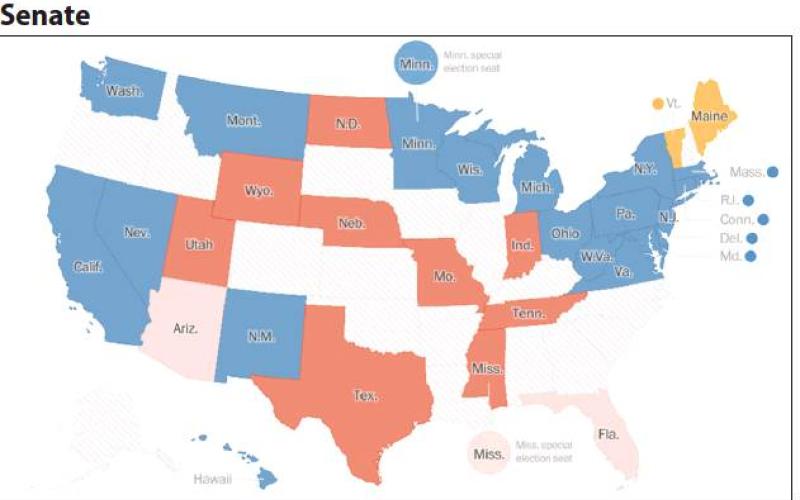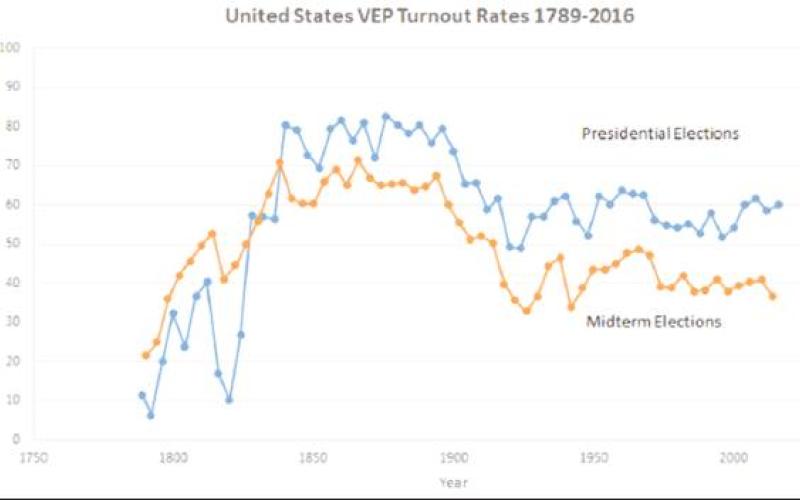Midterms results are as expected as U.S. has record-setting turnout
Texas has voted to remain red in the 2018 midterms, sending Sen. Ted Cruz back to Washington for another term, while keeping the GOP stronghold in place in the state legislature with Greg Abbott, Dan Patrick and Ken Paxton.
In terms of Breckenridge and Stephens County, Rep. Jodey Arrington bested Miguel Levario, bolstering 75 percent of the vote to win District 19. Rep Mike Conway in District 11 received 80 percent. In Stephens County, not one Democrat won an election. The only proposition on the board, the “legal sale of beer and wine,” passed with 982 votes to 266 against.
Outside of the U.S. House of Representatives, Texas did not elect a single Democrat in any of the races. Meanwhile, on the national level, the Democrats got part of their “blue wave” by winning the House, while the Republicans were able to gain more seats in the Senate. Democrats at the moment control 220 seats to Republicans 196. In the Senate, Republicans control 51 and are likely to gain 2-3 more, while Democrats are sitting at 46.
In terms of state legislatures, the Republicans will maintain control of the majority, but will net lose an estimated six seats. Entering the election, Republicans had 33 of the 50 state legislatures. It stood to reason with 36 up for grabs, the Republicans had more to lose in the realm than the Democrats did. They are on track to gain 20 back, bringing their total up to a projected 27, but Democrats will have 23, which is a net increase of six seats. As of publication, the GOP controls 25 seats, as not all elections are finalized yet.
Why the House flipped
Most political experts had the House of Representatives flipping to the Democrats. The reasons for this were rooted in polling data, as well as historical trends. The phenomena is often referred to as “midterm loss,” which is when the president’s party tends to lose seats in the immediate midterm after a presidential election. In the last 21 midterms, the president’s party has lost an average of 30 seats in the House and four in the Senate. In this race, Democrats needed to gain 23 seats to win a majority. At the moment, there have been 32 seats that have flipped from Republican to Democrat, and seven seats that flipped from Democrat to Republican.
Reasons for explaining why this happens tend to vary. Some chalk it up to the opposing party being more riled up in the midterms after losing the presidency and as a result, turn out to vote more, while the winning party, in the case the Republicans, tend to stay home and sort of rest on their victory. While it is unclear at this time, and unlikely, that Republicans lost the House because of poor voter turnout, the Democrats had a higher turnout than the 2016 election.
According to exit polls, Democrats accounted for 38 percent of voters, while GOP accounted for 32 percent and independents at 30 percent, according to ABC News. This compares to 2014, which had a ratio of 36-37-27 and 37-33-29 in 2016.
Why the Senate stayed the same
You would be hard pressed to find a political analyst projecting the Democrats would take control of the Senate. Of the 35 Senators up for re-election this year, 26 of them were Democrats to only nine Republicans. This means there are more seats up for grabs on the Democratic side, and considering the Democrats already had a minority in the Senate with 47 seats (49 if you include the two independents who caucus with the Democrats), the chance of them losing seats was much higher than them gaining seats. This proved to be the case after results, as Republicans are set to have gained three seats, bringing their projected total to 54.
What this means now
The dynamics of Washington have been moderately changed now that we have a split in the House and Senate. The last time the two chambers had different parties was after the 2010 midterm election, which saw the Democrats lose control of the House to the Republicans, but maintain the Senate. This dynamic would stay this way until the 2014 midterm, which saw the Republicans gain control of both chambers. The GOP maintained that control in 2016 as well.
The last time you saw this specific dynamic, that is the GOP controlling Senate and the Democrats controlling the House, you would have to go back to the 1984 presidential election, when Ronald Reagan was in office. In a majority of elections though, one party has typically gained control of both chambers.
Concerns over partisanship are as potent as ever with this setup, as concerns about work not getting done due to differing parties has become a voice of concern. President Donald Trump a few weeks ago was quoted saying if the Republicans lost the House, he believed he could work with Democrats to get things done.
Other interesting races around the country
Some interesting elections from across the country include recounts in Florida for their senate and governor races. Results are expected at the end of this week. Republican Marsha Blackburn took the Senate victory in Tennessee, while Sen. Joe Manchin (Democrat) was able to hold onto his Senate seat in West Virginia, which heavily supported President Donald Trump in 2016. Some first-times in politics also occurred, including the first openly gay man elected governor of a state in Colorado, and the first Native American woman and Muslim woman elected, both of which had two. Arizona and Tennessee elected their first female Senators. Texas also elected two Latina congresswomen, who represent the 16th and 29th District, both of which are the first in the state’s history. Maine and South Dakota also elected their first female governors, and Alexandria Ocasio-Cortez, a darling of the left, is now the youngest woman ever elected to Congress at 29 years old. These firsts are according to AP.
- Log in to post comments





